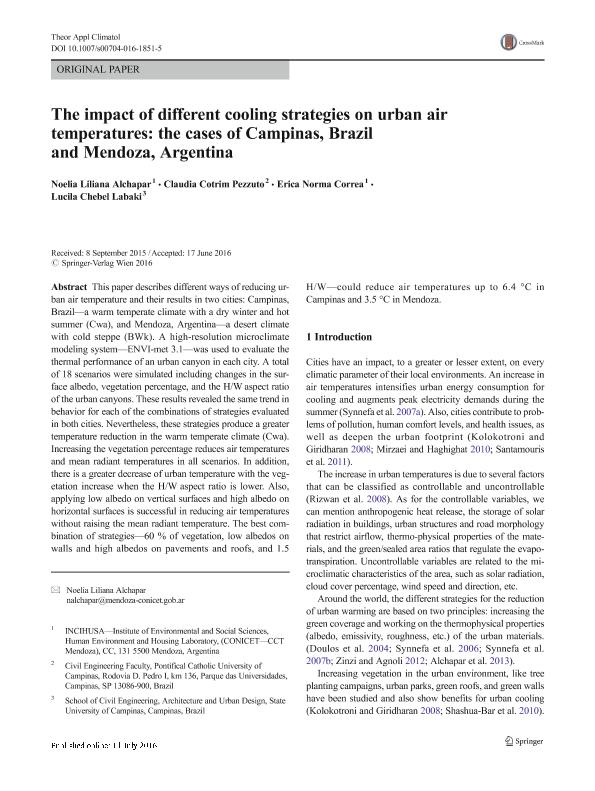Mostrar el registro sencillo del ítem
dc.contributor.author
Alchapar, Noelia Liliana

dc.contributor.author
Cotrim Pezzuto, Claudia

dc.contributor.author
Correa Cantaloube, Erica Norma

dc.contributor.author
Labaki, Lucila Chebel
dc.date.available
2018-04-03T16:10:51Z
dc.date.issued
2016-07
dc.identifier.citation
Alchapar, Noelia Liliana; Cotrim Pezzuto, Claudia; Correa Cantaloube, Erica Norma; Labaki, Lucila Chebel; The impact of different cooling strategies on urban air temperatures: the cases of Campinas, Brazil and Mendoza, Argentina; Springer Wien; Theory & Application Climatology; 130; 1-2; 7-2016; 35-50
dc.identifier.issn
0177-798X
dc.identifier.uri
http://hdl.handle.net/11336/40492
dc.description.abstract
This paper describes different ways of reducing urban air temperature and their results in two cities: Campinas - Brazil- a warm temperate climate with a dry winter and hot summer (CWa), and Mendoza- Argentina -a desert climate with cold steppe (BWk)-. A high-resolution microclimate modeling system -ENVI-met 3.1- was used to evaluate the thermal performance of an urban canyon in each city. A total of 18 scenarios were simulated including changes in the surface albedo, vegetation percentage and the H/W aspect ratio of the urban canyons. These results revealed the same trend in behavior for each of the combinations of strategies evaluated in both cities. Nevertheless, these strategies produce a greater temperature reduction in the warm temperate climate (CWa). Increasing the vegetation percentage reduces air temperatures and mean radiant temperatures in all scenarios. In addition, there is a greater decrease of urban temperature with the vegetation increase when the H/W aspect is lower. Also, applying low albedo on vertical surfaces and high albedo on horizontal surfaces is successful in reducing air temperatures without raising mean radiant temperature. The best combination of strategies - 60% of vegetation, low albedos on walls and high albedos on pavements and roofs and 1.5 H/W- could reduce air temperatures up to 6.4 ºC in Campinas and 3.5 ºC in Mendoza.
dc.format
application/pdf
dc.language.iso
eng
dc.publisher
Springer Wien

dc.rights
info:eu-repo/semantics/openAccess
dc.rights.uri
https://creativecommons.org/licenses/by-nc-sa/2.5/ar/
dc.subject
Urban Warming
dc.subject
Mitigation
dc.subject
Vegetation
dc.subject
Albedo
dc.subject
H/W Aspect Ratio
dc.subject
Envi-Met Software 3.1.
dc.subject.classification
Ingeniería Medioambiental y Geológica, Geotécnicas

dc.subject.classification
Ingeniería del Medio Ambiente

dc.subject.classification
INGENIERÍAS Y TECNOLOGÍAS

dc.title
The impact of different cooling strategies on urban air temperatures: the cases of Campinas, Brazil and Mendoza, Argentina
dc.type
info:eu-repo/semantics/article
dc.type
info:ar-repo/semantics/artículo
dc.type
info:eu-repo/semantics/publishedVersion
dc.date.updated
2018-03-27T13:37:10Z
dc.identifier.eissn
1434-4483
dc.journal.volume
130
dc.journal.number
1-2
dc.journal.pagination
35-50
dc.journal.pais
Austria

dc.journal.ciudad
Viena
dc.description.fil
Fil: Alchapar, Noelia Liliana. Consejo Nacional de Investigaciones Científicas y Técnicas. Centro Científico Tecnológico Conicet - Mendoza. Instituto de Ambiente, Hábitat y Energía; Argentina. Consejo Nacional de Investigaciones Científicas y Técnicas. Centro Científico Tecnológico Conicet - Mendoza. Instituto de Ciencias Humanas, Sociales y Ambientales; Argentina
dc.description.fil
Fil: Cotrim Pezzuto, Claudia. Pontifícia Universidade Católica de Campinas; Brasil
dc.description.fil
Fil: Correa Cantaloube, Erica Norma. Consejo Nacional de Investigaciones Científicas y Técnicas. Centro Científico Tecnológico Conicet - Mendoza. Instituto de Ciencias Humanas, Sociales y Ambientales; Argentina. Consejo Nacional de Investigaciones Científicas y Técnicas. Centro Científico Tecnológico Conicet - Mendoza. Instituto de Ambiente, Hábitat y Energía; Argentina
dc.description.fil
Fil: Labaki, Lucila Chebel. Universidade Estadual de Campinas; Brasil
dc.journal.title
Theory & Application Climatology

dc.relation.alternativeid
info:eu-repo/semantics/altIdentifier/url/https://link.springer.com/article/10.1007%2Fs00704-016-1851-5
dc.relation.alternativeid
info:eu-repo/semantics/altIdentifier/doi/http://dx.doi.org/10.1007/s00704-016-1851-5
Archivos asociados
